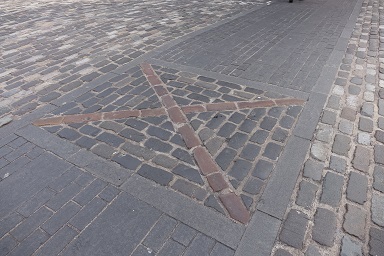Mercat Cross
Mercat Cross
Markets have been held in St Andrews since at least the late twelfth century. In the 1190s it was decided that St Andrews' market-place should be on "the land of Lambinus" - an open space roughly where the wide section of Market Street is today. As in other Scottish towns, the site of the market was denoted by a stone pillar known as the mercat (or market) cross. The mercat cross was an important meeting place for the residents of St Andrews and public announcements were often made there. On occasions, executions also took place here. The St Andrews mercat cross survived into the mid-seventeenth century, but seems to have been demolished at some stage before 1820. The location of the old mercat cross is indicated by an x-shape in the paving on the road.
Street View
Additional Information
Location: Market Street. Date Built: Probably twelfth and sixteenth centuries (structure now demolished).
We do not know exactly when St Andrews first acquired a mercat cross. However, the late twelfth-century document which records the siting of St Andrews Market on the land of Lambinus also refers to the moving of the mercat cross to this area - implying that the town already had a mercat cross at this stage.
It is thought that most mercat crosses were originally cross shaped. However, by the late sixteenth century other designs had been adopted. The earliest drawing of the St Andrews mercat cross dates from the 1580s and shows a simple stone pillar standing on top of a small flight of steps.
In 1433 Paul Kravar was burnt near the Mercat Cross. Kravar originally came from Bohemia and was executed for spreading the teachings of Jan Hus (a supposedly heretical religious reformer from Prague).
A seventeenth-century executioner's axe from St Andrews still survives and can be seen in the town museum.

